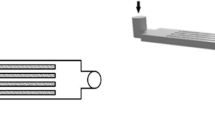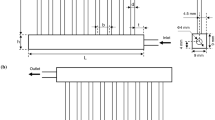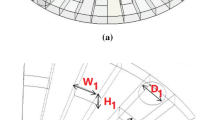Abstract
Heat exchangers are used to transfer energy from one medium to another and increase contact area for higher efficiency. In case of fluids, higher flow area would lead to high/low flow zones that severely affect the fluid dynamics and thermal performance. Channels are used to distribute the flow uniformly to fully utilize the whole heat exchanger area. The flow uniformity in a flow distribution manifold is dependent on several factors such as flow rate, inlet and exit locations, and the manifold and channel geometrical configuration. In the current work, flow distribution measurements were performed using a particle image velocimetry (PIV) technique in two types of rectangular manifolds. The experimental results are further verified against the results obtained from numerical modeling with similar trends. The flow distribution in U- and Z-type arrangements are evaluated and compared with ten channels incorporated in the design. It was found that the flow is more in the channels near the inlet for U-type design, while more near the outlet for the Z-type. An increase in the inlet flow rate enhances the flow distribution for the U-type while results in more maldistribution for the Z-type. For the U-type, the normalized velocity varies from 1.34 to 0.52 in a wide manifold, and between 2.82 and 0.18 for a narrow manifold. A U-type wider manifold is recommended for all conditions examined in this work since at lower flow rates, both have similar mirrored distribution, while at higher flow rates, U-type manifold has better flow distribution.










Similar content being viewed by others
Abbreviations
- A :
-
Cross-sectional area (m3)
- b :
-
Width of the channel (m)
- e :
-
Relative error [1]
- h :
-
Height of the channel (m)
- \(\dot{m}\) :
-
Mass flow rate (kg m−3)
- N :
-
Number of cells in mesh
- P :
-
Pressure (Pa)
- p :
-
Apparent order [1]
- r :
-
Grid refinement factor [1]
- R :
-
Calculated variable
- S :
-
Standard deviation
- u, w :
-
Perpendicular velocity components (m s−1)
- U :
-
Uncertainty in a variable
- v :
-
Axial velocity (m s−1)
- X :
-
Independent variable
- µ :
-
Fluid viscosity (kg m−1 s−1)
- ϕ :
-
Value of the variable for numerical uncertainty analysis
- ρ :
-
Density (kg m−3)
- a:
-
Approximate
- c:
-
Channel
- e:
-
Exit
- ext:
-
Extrapolated
- i :
-
Channel numbers (1-10)
- in:
-
Inlet
References
Celik, I.B.; Ghia, U.; Roache, P.J.; Freitas, C.J.: Procedure for estimation and reporting of uncertainty due to discretization in CFD applications. J. Fluids Eng. 130, 078001 (2008). https://doi.org/10.1115/1.2960953
Bahaidarah, H.M.S.; Baloch, A.A.B.; Gandhidasan, P.: Uniform cooling of photovoltaic panels: a review. Renew. Sustain. Energy Rev. 57, 1520–1544 (2016). https://doi.org/10.1016/j.rser.2015.12.064
Siddiqui, M.U.; Siddiqui, O.K.; Al-Sarkhi, A.; Arif, A.F.M.; Zubair, S.M.: A novel heat exchanger design procedure for photovoltaic panel cooling application: an analytical and experimental evaluation. Appl. Energy 239, 41–56 (2019). https://doi.org/10.1016/j.apenergy.2019.01.203
Reddy, S.R.; Ebadian, M.A.; Lin, C.-X.: A review of PV–T systems: thermal management and efficiency with single phase cooling. Int. J. Heat Mass Transf. 91, 861–871 (2015). https://doi.org/10.1016/j.ijheatmasstransfer.2015.07.134
Zhao, J.; Huang, S.; Gong, L.; Huang, Z.: Numerical study and optimizing on micro square pin–fin heat sink for electronic cooling. Appl. Therm. Eng. 93, 1347–1359 (2016). https://doi.org/10.1016/J.APPLTHERMALENG.2015.08.105
Agrawal, G.; Kaisare, N.S.; Pushpavanam, S.; Ramanathan, K.: Modeling the effect of flow mal-distribution on the performance of a catalytic converter. Chem. Eng. Sci. 71, 310–320 (2012). https://doi.org/10.1016/j.ces.2011.12.041
Kim, N.-H.; Sin, T.-R.: Two-phase flow distribution of air–water annular flow in a parallel flow heat exchanger. Int. J. Multiph. Flow 32, 1340–1353 (2006). https://doi.org/10.1016/j.ijmultiphaseflow.2006.07.005
Hassan, J.M.; Mohamed, T.A.; Mohammed, W.S.; Alawee, W.H.: Modeling the uniformity of manifold with various configurations. J. Fluids 2014, 1–8 (2014). https://doi.org/10.1155/2014/325259
Hasan, M.I.; Rageb, A.A.; Yaghoubi, M.; Homayoni, H.: Influence of channel geometry on the performance of a counter flow microchannel heat exchanger. Int. J. Therm. Sci. 48, 1607–1618 (2009). https://doi.org/10.1016/j.ijthermalsci.2009.01.004
Perlmutter, M.: Inlet and exit-header shapes for uniform flow through a resistance parallel to the main stream. J. Basic Eng. 83, 361 (1961). https://doi.org/10.1115/1.3658963
Tereda, F.A.; Srihari, N.; Sunden, B.; Das, S.K.: Experimental investigation on port-to-channel flow maldistribution in plate heat exchangers. Heat Transf. Eng. 28, 435–443 (2007). https://doi.org/10.1080/01457630601163769
Rao, B.P.; Sunden, B.; Das, S.K.: An experimental and theoretical investigation of the effect of flow maldistribution on the thermal performance of plate heat exchangers. J. Heat Transf. 127, 332 (2005). https://doi.org/10.1115/1.1860568
Bajura, R.A.; Jones Jr., E.H.: Flow distribution manifolds. J. Fluids Eng. 98, 654 (1976). https://doi.org/10.1115/1.3448441
Yang, H.; Wang, Y.; Ren, M.; Yang, X.: Effect of the rectangular exit-port geometry of a distribution manifold on the flow performance. Appl. Therm. Eng. 117, 481–486 (2017). https://doi.org/10.1016/j.applthermaleng.2017.02.046
Tong, J.C.K.; Sparrow, E.M.; Abraham, J.P.: Attainment of flowrate uniformity in the channels that link a distribution manifold to a collection manifold. J. Fluids Eng. 129, 1186 (2007). https://doi.org/10.1115/1.2754319
Rao, B.P.; Das, S.K.: An experimental study on the influence of flow maldistribution on the pressure drop across a plate heat exchanger. J. Fluids Eng. 126, 680 (2004). https://doi.org/10.1115/1.1779664
Miura, R.Y.; Galeazzo, F.C.C.; Tadini, C.C.; Gut, J.A.W.: The effect of flow arrangement on the pressure drop of plate heat exchangers. Chem. Eng. Sci. 63, 5386–5393 (2008). https://doi.org/10.1016/j.ces.2008.07.029
Fu, H.; Watkins, A.P.; Yianneskis, M.: The effects of flow split ratio and flow rate in manifolds. Int. J. Numer. Methods Fluids 18, 871–886 (1994). https://doi.org/10.1002/fld.1650180906
Koh, J.-H.; Seo, H.-K.; Lee, C.G.; Yoo, Y.-S.; Lim, H.C.: Pressure and flow distribution in internal gas manifolds of a fuel-cell stack. J. Power Sources 115, 54–65 (2003). https://doi.org/10.1016/S0378-7753(02)00615-8
Makinde, O.D.; Animasaun, I.L.: Bioconvection in MHD nanofluid flow with nonlinear thermal radiation and quartic autocatalysis chemical reaction past an upper surface of a paraboloid of revolution. Int. J. Therm. Sci. 109, 159–171 (2016). https://doi.org/10.1016/j.ijthermalsci.2016.06.003
Makinde, O.D.; Animasaun, I.L.: Thermophoresis and Brownian motion effects on MHD bioconvection of nanofluid with nonlinear thermal radiation and quartic chemical reaction past an upper horizontal surface of a paraboloid of revolution. J. Mol. Liq. 221, 733–743 (2016). https://doi.org/10.1016/j.molliq.2016.06.047
Bogojevic, D.; Sefiane, K.; Walton, A.J.; Christy, J.R.E.; Cummins, G.; Lin, H.: Investigation of flow distribution in microchannels heat sinks. Heat Transf. Eng. 30, 1049–1057 (2009). https://doi.org/10.1080/01457630902921287
Kumar, S.; Singh, P.K.: Effects of flow inlet angle on flow maldistribution and thermal performance of water cooled mini-channel heat sink. Int. J. Therm. Sci. 138, 504–511 (2019). https://doi.org/10.1016/J.IJTHERMALSCI.2019.01.014
Zhu, J.; Zhang, W.; Li, Y.; Ji, P.; Wang, W.: Experimental study of flow distribution in plate–fin heat exchanger and its influence on natural gas liquefaction performance. Appl. Therm. Eng. 155, 398–417 (2019). https://doi.org/10.1016/J.APPLTHERMALENG.2019.04.020
Liu, Y.; Wang, S.: Distribution of gas-liquid two-phase slug flow in parallel micro-channels with different branch spacing. Int. J. Heat Mass Transf. 132, 606–617 (2019). https://doi.org/10.1016/J.IJHEATMASSTRANSFER.2018.12.040
Kim, D.; Yu, C.H.; Yoon, S.H.; Choi, J.S.: Effects of manifold geometries on flow distribution to parallel microchannels. J. Mech. Sci. Technol. 25, 3069–3074 (2011). https://doi.org/10.1007/s12206-011-1220-3
Datta, A.B.; Majumdar, A.K.: A calculation procedure for two phase flow distribution in manifolds with and without heat transfer. Int. J. Heat Mass Transf. 26, 1321–1328 (1983). https://doi.org/10.1016/S0017-9310(83)80063-5
Quintanar, N.R.; Nguyen, T.; Vaghetto, R.; Hassan, Y.A.: Natural circulation flow distribution within a multi-branch manifold. Int. J. Heat Mass Transf. 135, 1–15 (2019). https://doi.org/10.1016/J.IJHEATMASSTRANSFER.2019.01.102
Faure, T.M.; Lusseyran, F.; Gougat, P.; Launay, F.: Experimental investigation of the flow distribution inside a tubular heat exchanger. J. Fluids Eng. 128, 1218 (2006). https://doi.org/10.1115/1.2353277
Pigford, R.L.; Ashraf, M.; Miron, Y.D.: Flow distribution in piping manifolds. Ind. Eng. Chem. Fundam. 22, 463–471 (1983). https://doi.org/10.1021/i100012a019
Dhahad, H.A.; Alfayydh, E.M.; Fahim, K.H.: Effect of flow field design and channel/header ratio on velocity distribution: an experimental approach. Therm. Sci. Eng. Prog. 8, 118–129 (2018). https://doi.org/10.1016/J.TSEP.2018.08.013
Gandhi, M.S.; Ganguli, A.A.; Joshi, J.B.; Vijayan, P.K.: CFD simulation for steam distribution in header and tube assemblies. Chem. Eng. Res. Des. 90, 487–506 (2012). https://doi.org/10.1016/j.cherd.2011.08.019
Griffini, G.; Gavriilidis, A.: Effect of microchannel plate design on fluid flow uniformity at low flow rates. Chem. Eng. Technol. 30, 395–406 (2007). https://doi.org/10.1002/ceat.200600324
Minqiang, P.; Yong, T.; Wei, Z.; Longsheng, L.: Flow distribution among microchannels with asymmetrical manifolds. In: 2007 IEEE International Conference on Control Automation, pp. 193–197 IEEE (2007). https://doi.org/10.1109/ICCA.2007.4376345
Mohammadi, M.; Jovanovic, G.N.; Sharp, K.V.: Numerical study of flow uniformity and pressure characteristics within a microchannel array with triangular manifolds. Comput. Chem. Eng. 52, 134–144 (2013). https://doi.org/10.1016/j.compchemeng.2012.12.010
Tonomura, O.; Tanaka, S.; Noda, M.; Kano, M.; Hasebe, S.; Hashimoto, I.: CFD-based optimal design of manifold in plate-fin microdevices. Chem. Eng. J. 101, 397–402 (2004). https://doi.org/10.1016/j.cej.2003.10.022
Solovitz, S.A.; Mainka, J.: Manifold design for micro-channel cooling with uniform flow distribution. J. Fluids Eng. 133, 051103 (2011). https://doi.org/10.1115/1.4004089
Weitbrecht, V.; Lehmann, D.; Richter, A.: Flow distribution in solar collectors with laminar flow conditions. Sol. Energy 73, 433–441 (2002). https://doi.org/10.1016/S0038-092X(03)00006-9
Measurement Principles of PIV. https://www.dantecdynamics.com/measurement-principles-of-piv. Accessed 19 Apr 2019
Sundrum Solar. http://sundrumsolar.com/index.php/products. Accessed 15 Oct 2011
Cengel, Y.A.; Cimbala, J.M.: Fluid Mechanics: Fundamentals and Applications, 3rd edn. McGraw-Hill Education, New York (2013)
Product Documentation. Fluent 15, ANSYS Inc.. http://www.ansys.com/Products/Fluids/ANSYS-Fluent2014
Siddiqui, O.K.: Analytical investigation of flow distribution in heat exchanger manifolds. PhD Dissertation, ME Dept. KFUPM (2018)
Das, R.: Inverse analysis of Navier–Stokes equations using simplex search method. Inverse Probl. Sci. Eng. 20, 445–462 (2012). https://doi.org/10.1080/17415977.2011.629046
Das, R.: A simulated annealing-based inverse computational fluid dynamics model for unknown parameter estimation in fluid flow problem. Int. J. Comut. Fluid Dyn. 26, 499–513 (2012). https://doi.org/10.1080/10618562.2011.632375
Gupta, R.; Debnath, B.K.; Das, R: CFD analysis of two-bucket Savonius rotor using fluent package. In: European Wind Energy Conference and Exhibition (2009)
Sciacchitano, A.; Wieneke, B.: PIV uncertainty propagation. Meas. Sci. Technol. (2016). https://doi.org/10.1088/0957-0233/27/8/084006
Journal of Fluids Engineering Editorial Policy Statement on the Control of Numerical Accuracy. https://journaltool.asme.org/templates/jfenumaccuracy.pdf. Accessed 28 Feb 2019
Sciacchitano, A.; Wieneke, B.; Scarano, F.: PIV uncertainty quantification by image matching. Meas. Sci. Technol. 24, 045302 (2013). https://doi.org/10.1088/0957-0233/24/4/045302
Morris, A.S.; Langari, R.: Measurement and Instrumentation. Elsevier, Amsterdam (2012). https://doi.org/10.1016/C2009-0-63052-X
Acknowledgements
The authors would acknowledge the support provided by King Fahd University of Petroleum and Minerals (KFUPM) through its research Project IN171048.
Author information
Authors and Affiliations
Corresponding author
Appendix: Uncertainty Analysis
Appendix: Uncertainty Analysis
Measurement of the velocity with the use of PIV involves correlating multiple images to identify the change in the position of illuminated particles. In this method, the time is a fixed value based on the frame rate of the images taken by the imaging device. Hence, it is the distance measurement that has an uncertainty associated with it. Regarding the uncertainty associated with the PIV system, multiple values have been found in the literature. Sciacchitano et al. [49] discussed in detail the procedure to calculate the actual uncertainty in the PIV measurements by super-resolution principle, where the cross-correlated distance is compared with the residual between the particles in the paired images. This comparison was made for all the particles, and in this way, the uncertainties associated with the PIV measurements were evaluated, and 0.1 pixel was used as the accuracy of the PIV systems. For the current work, the velocity was about 1.6 pixels, which converts to about 6.25% uncertainty. It was also determined that the use of the larger image can result in large variations. It was also noticed in the current work that if the images of the complete channel were used, it resulted in an error of about an order of magnitude. For this reason, only a small portion of suitably illuminated particles was used for each channel that resulted in excellent results. Furthermore, the RMS error resulted in an accuracy of 0.01 pixels. In another study [47], the uncertainty of average velocities was found to be within 5% of the actual values. Hence, a value of 5% can be associated with the PIV system velocity measurements.
The uncertainty analysis is performed on data that are derived from multiple experimentally determined quantities. In this regard, the data reduction equation is of the form [50],
where R is a calculated variable as a function of parameters X1, X2, X3, etc.
The uncertainty analysis of this equation is of the following form,
where U represents the total uncertainty associated with a particular variable.
The uncertainty analysis equation provides information on how the uncertainties of the individually determined quantities are propagated to affect the uncertainty of the calculated variable. Concerning the uncertainty in the velocity itself (not its measurement), the following data reduction equation is used to find the relation between the independent measurements that affect the velocity [41].
This relation can be explained in more detail as follows. The flow is being measured by a rotameter; hence, we have uncertainty related to the flow measurement. This flow rate is divided into 10 channels, such that the average flow rate is 1/10th in each channel. This mass flow rate is converted into velocity by using the continuity equation, where the density is standard for water. The area, which is the product of width (b) and depth (h) of the channel, has its measurement uncertainty. Hence, the three factors affecting the uncertainty in velocity are the width and height of the channel in addition to the flowmeter.
By performing uncertainty analysis Eq. (4) on the data reduction Eq. (5), we obtain the following expression
where the two terms on the right side are evaluated as
and
Hence, Eq. (6) becomes
It is important to note that if there is a higher-order term in the data reduction equation, the corresponding uncertainty term of that variable has a higher contribution toward the total uncertainty. In the current cases, all the terms are of the first order, so a simple root-sum-square (RSS) of the uncertainties will provide the total uncertainty. Here, the area can be split into the width and height of the channel separately to account for their independent uncertainties as:
The measurements of the height and width of each channel were obtained using a digital Vernier caliber of resolution 0.01 mm. The maximum and minimum values, obtained, are presented in Table 4.
The standard deviation is found by summing the square of the difference of each point from the mean value, divided by one less than the total number of samples. The square root of this value is the standard deviation, as shown by Eq (11). The normalized value is obtained in percentage by dividing the standard deviation by the average value [50].
The flow rate, being supplied by a continuous centrifugal pump, is measured with a rotameter which has a measurement uncertainty of 4%. By inserting the values of 4% for mass flow rate uncertainty of the rotameter, 5.33% for width, and 0.97% for height. The total uncertainty in the velocity of the channel is about 6.85%. This is the uncertainty associated with the actual velocity, not velocity measurements.
Combining the PIV measurement error (5%) with the calculated velocity uncertainty (6.85%.), we can obtain the total uncertainty in velocity measurement, for the current setup, using RSS to be about 8.48% which is presented as ± 4.24%. This value is used for all the experimental data presented in this work.
Rights and permissions
About this article
Cite this article
Siddiqui, O.K., Al-Zahrani, M., Al-Sarkhi, A. et al. Flow Distribution in U- and Z-Type Manifolds: Experimental and Numerical Investigation. Arab J Sci Eng 45, 6005–6020 (2020). https://doi.org/10.1007/s13369-020-04691-4
Received:
Accepted:
Published:
Issue Date:
DOI: https://doi.org/10.1007/s13369-020-04691-4




